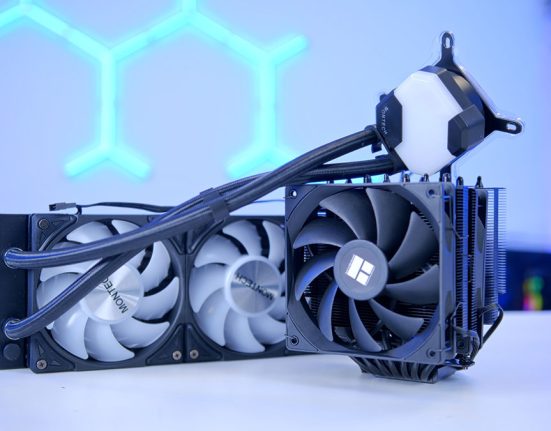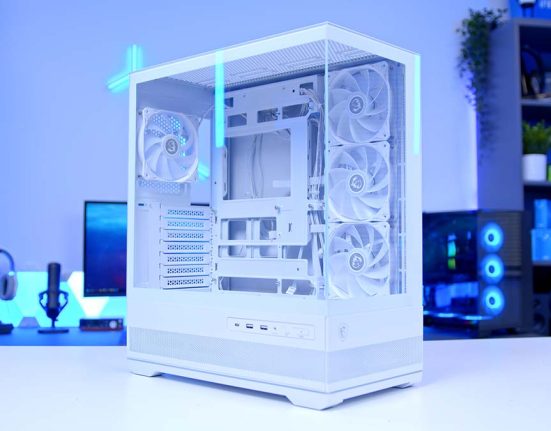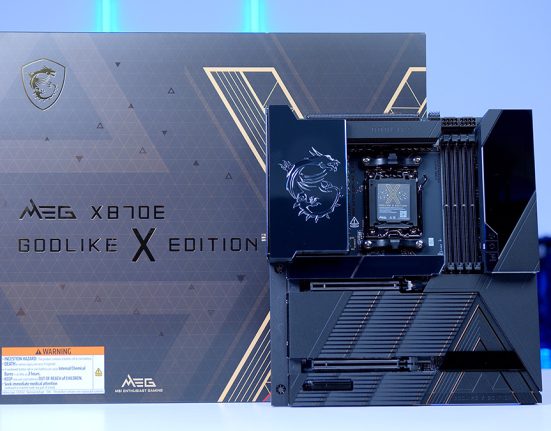The MSI B760M Gaming Plus WiFi is a budget motherboard designed to offer PC builders solid features and performance at a competitive price point, primarily geared towards gaming. With Gen4 SSD compatibility, strong networking, and a robust set of front IO, the B760M Gaming Plus WiFi is well-equipped for a low-end system. But with Intel 15th-Gen CPUs looming on the horizon, is a board like the B760M Gaming Plus WiFi still worth picking up in 2024? We’ve tested this board rigorously in a series of benchmarks and builds to see if it’s worth purchasing compared to other current Intel competitor boards.
The B760 chipset has a solid selection of boards to choose from. With the launch of 14th-Gen CPUs in 2023, the list of boards has only grown more extensive, with many of the latest PCBs providing an updated set of features while still maintaining competitive prices. For this reason, the B760M Gaming Plus WiFi has its work cut out for it, based on the sheer number of alternatives offering similar features and MSRPs.
In this review, we’ve examined the B760M Gaming Plus WiFi in great detail, delving into its specs, design, features, and connectivity options to determine whether it’s worth purchasing in 2024.
Buy the MSI B760M Gaming Plus WiFi on:
Specification
The MSI B760M Gaming Plus WiFi (not to be confused with the Gigabyte B760M Gaming WiFi Plus) is a Micro-ATX motherboard primarily geared at the budget end of the market. It offers RAM overclocking speeds up to 6800MT/s with support for up to 256GB of DDR5 memory. While the RAM overclocking speed is slower than some other B760 boards we’ve looked at, you won’t see a considerable performance boost past 6000MT/s, which is generally the sweet spot for gaming.
Regarding VRM power phases, the B760M Gaming Plus WiFi has a 12+1+1 configuration, which is pretty solid for a cheaper board. As a point of comparison, the B760 DS3H AX from Gigabyte uses an 8+2+1 config. It’s worth noting that while the B760 chipset can’t overclock the CPU clock speeds, a higher phase count means that power delivery is spread better across the VRMs, resulting in better temperatures and more stable voltages.

For expansion, the B760M Gaming Plus WiFi offers a full-size x16 slot with Gen4 bandwidth. Unfortunately, the secondary slot runs at x4 speeds. This board also features two Gen4 M.2 slots. It would be nice to see an additional slot to provide better upgradeability, but this is excusable because this is a cheaper motherboard.
| Specification | MSI B760M Gaming Plus WiFi |
|---|---|
| Form Factor | Micro-ATX |
| Supported Memory | 256GB DDR5 6800MT/s |
| PCI-E x16 Slots | 2 x PCI-E 4.0 |
| PCI-E x4 Slots | 2 x PCI-E 4.0 |
| VRM Power Phases | 12+1+1 |
| Front IO | 2 x USB 3.2 Gen1 Type-A 1 x USB 3.2 Gen1 Type-C 2 x USB 2.0 |
| Rear IO | 2 x USB 3.2 Gen1 Type-A 2 x USB 3.2 Gen2 Type-A 2 x USB 2.0 |
| Audio | 3 x Audio Jacks |
| Networking | 2.5 Gigabit LAN WiFi 6E |
The IO selection is a bit of a mixed bag. The front IO has five headers. Two are USB 3.2 Gen1 Type-A, one is USB 3.2 Gen1 Type-C, and the final two are for USB 2.0 ports. The rear IO houses six ports: two USB 2.0, two USB 3.2 Gen2 Type-A, and two USB 3.2 Gen1 Type-A. It’s been quite some time since I’ve seen a motherboard with only six ports. While some gamers may only need a couple of ports for some peripherals, seasoned PC builders may be looking for extra space for charging, webcams, or a monitor upstream connection, so the IO here is relatively limited.
Networking is decent. Prospective buyers can choose between 2.5 Gigabit LAN or WiFi 6E, offering some options for those with a wired or wireless setup. As for pricing, the B760M Gaming Plus WiFi is available for around $150 at the time of writing. This is a fair asking price, but similar boards like the B760M Pro RS from ASRock or the Gigabyte B760M Gaming Plus WiFi are alternatives within this price bracket.
What’s in the Box?
Manufacturers generally include additional accessories inside the motherboard packaging, such as M.2 standoffs, SATA cables, WiFi antennas, and more. These are designed to ease the building process or provide quality-of-life features that save you money. The B760M Gaming Plus WiFi offers a few extras worth covering.
The first item is a quick installation guide that details some of the motherboard’s features and shows how to use and install it. It also has a QR code for a mobile version, which can be helpful if you’ve never built a PC before.

Two WiFi antennas can be plugged into the WiFi 6E ports on the board’s rear IO. These aren’t essential, but they extend the range of a WiFi signal and are worth plugging in where possible.

MSI has also included a SATA data cable for those with older drives. Although these cables aren’t expensive to buy on their own, it’s a solid value add for those that use SATA-based storage.

A small bag houses some M.2 standoffs and screws. This is helpful for those planning to use the secondary SSD slot, as it doesn’t have a built-in standoff.

Note: The final item in the box would have been a rear IO shield, which is necessary for this board. However, it seems to have been misplaced and is likely sitting in a case that was previously used with this board.
MSI B760M Gaming Plus WiFi Design
At a glance, the B760M Gaming Plus WiFi is a relatively rugged and barebones motherboard compared to other options we’ve looked at. It uses a black PCB in the Micro-ATX form factor, so it has less slot and header space due to the board’s physical shrinkage.

MSI has included a couple of heatsinks to spice things up a little. The rear IO and VRMs have a silvery heatsink to keep components cool and are covered in black and green lines, bringing some colour to the board. Additionally, there’s a small heatsink at the bottom right and another covering the primary SSD slot with the ‘MSI Gaming’ branding.

There’s not much else on offer from an aesthetic point of view. Generally, less expensive motherboards tend to sacrifice the design to reduce costs, resulting in a no-frills look. I don’t mind the design. It’s nice to see some of the raw components on the PCB occasionally. I prefer black heatsinks to the contrasting silver, but it appeals to those building a lighter-themed system. Overall, the target demographic of the B760M Gaming Plus WiFi is those looking to pick up an affordable motherboard, which sometimes comes at the cost of design.
Connectivity Options
Graphics Card Slot
The MSI B760M Gaming Plus WiFi features two full-length x16 PCI-E slots. The primary slot (underneath the SSD slot) is a Gen4 slot and uses the full 16 lanes for maximum bandwidth. This is where prospective buyers will need to plug in their graphics card.
This slot supports the current generation of AMD Radeon 7000 and NVIDIA RTX 4000 graphics cards. However, it limits upgradeability when the next generation of GPUs arrives, which are likely to use Gen5 bandwidth.

The secondary x16 slot is rated at x4 speeds, so we wouldn’t recommend installing a graphics card there. However, this slot is compatible with additional cards like a capture or network card.
M.2 Slots
Because this is a Micro-ATX motherboard, storage expansion is limited to two slots. Ultimately, it would be nice to see an extra slot, providing options for those with plenty of drives, but because of the size of the board, it isn’t a deal-breaker. Both M.2 slots are Gen4, using x4 speeds.

The top drive features a small heatsink designed to dissipate heat effectively and reduce the drive temperatures. It also utilises the MSI M.2 EZ Latch mechanism, so there’s no need to use any additional screws.

RAM DIMMs
Despite being a smaller motherboard, MSI has kept all four RAM DIMM slots. Sometimes, manufacturers will reduce the amount of slots to two to save on costs, but it’s nice to see a full selection here.

The B760M Gaming Plus WiFi can hold a maximum capacity of 256GB, which is ample upgrading room for those wanting to add more RAM later. It can also be overclocked to 6800MT/s, but the higher you go, the more likely system instability will occur.
Rear IO
The rear IO is limited compared to other motherboards at this price point. It’s worth pointing out first that the B760M Gaming Plus WiFi does not feature a built-in IO shield. This won’t be a significant point of contention for everyone, but the heatsink on top of the IO looks somewhat misleading and like it would house a shield for the IO.

Regardless, the B760M Gaming Plus WiFi has an OK selection of IO. There are six USB ports, four high-speed and two USB 2.0 ports. This is followed by 2.5 Gigabit LAN, WiFi 6E, and a basic range of audio jacks (3.5mm mic-in, audio-out, and line-in). Again, because this is a budget board, this can be somewhat excused, but it would be nice to see a couple of extra ports, even if they were USB 2.0.
What doesn’t make sense is that MSI has included four display outputs (two HDMI and two DisplayPort). I understand that this is catering to those without dedicated graphics, but two would have sufficed, opening up room for some extra ports. Nonetheless, the rear IO will do the job for those with a small selection of peripherals. Streamers and content creators may want to look elsewhere.
Internal Headers
CPU and Motherboard Power
The B760M Gaming Plus uses a more lightweight CPU power configuration than other motherboards. This likely comes down to the lack of overclocking support, resulting in an 8+4-pin configuration compared to two 8-pin EPS connectors.

For motherboard power, this board uses the same standard as pretty much every other motherboard on the market: a universal 20+4-pin connector. Sometimes, this is separated into two headers, but the board’s connector is lumped into 24 pins.

Front USB
This board strangely features a better USB selection on the front IO than it does for the rear. On the B760M Gaming Plus WiFi, you’ll find two USB 2.0 headers, two USB 3.2 Gen1 headers, and a single USB 3.2 Gen1 Type-C header. This amount of headers supports nine ports in total. However, the vast majority of cases aren’t going to have eight ports on the front IO, but it’s impressive regardless.
Both of the USB 2.0 headers are located underneath the secondary PCI-E slot. They sit beside each other but have no protective covering, so be careful when plugging them in.

The USB 3.0 and USB C headers are on the right side of the PCB, underneath the motherboard power connector. The second USB 3.0 connector is right-angled, which may cause clearance issues depending on the case being used.

Front Panel Power (JFP1)
JFP1, or front panel power, is typically located at the bottom right of the motherboard (bottom left on reverse connector designs). This is often the most finicky part of a build because getting the connectors into the correct pins can be tricky. However, we’ve started to see more manufacturers provide a unified header for JFP1, which means plugging it in is much more straightforward.

However, for those without a case with a single header for JFP1, you’ll need to plug in the individual pins. We generally recommend getting all of the pins plugged in, but ‘PWR_SW’ can be done as a standalone set of pins for those without SATA drives or a reset switch.
Pump and Fan Headers
The pump and fan headers on the B760M Gaming Plus WiFi are located in several different areas. For example, the main CPU fan is on the left of the RAM DIMMs. It might be slightly harder to plug in the header once more components are installed.

Instead of the pump fan sitting next to the CPU fan header, it’s been moved to the right side of the board, just below the top-right screw hole. It shouldn’t be too difficult to get this plugged in, but it might make your build look less tidy, especially if the cable is reaching directly across the width of the PCB.

RGB Headers
The RGB headers are quite dispersed on this board, and there are only three accessible headers. Above JFP1 is an addressable 3-pin RGB header, and a second is just above the pump fan.

The third (which isn’t addressable) is situated to the right of the HD audio header. This connector uses the 4-pin standard to sync up with other headers on the board, but individual LEDs can’t be controlled.
SATA Data Ports
While M.2 SSDs have become the standard across most modern builds, a significant range of PC builders still use SATA. These drives are still solid options for mass storage, especially if you’re on a budget. SATA drives require SATA data ports, which is why most motherboard manufacturers still include them. The B760M Gaming Plus WiFi features four of these ports towards the bottom right of the PCB.

Building with the B760M Gaming Plus WiFi
Building with the MSI B760M Gaming Plus WiFi was a breeze. Compared to the PROJECT ZERO reverse connector boards, we can install the CPU, RAM, SSD, and sometimes the CPU cooler on the board outside a case. Everything on this board was easy to access. Two small screws hold in the SSD heatsink, and the RAM DIMMs use a single push tab, saving some time.
It would be nice to see some more quality-of-life features, such as EZ latches and GPU release buttons, but because this is a budget board, it’s understandable why there aren’t as many of these proprietary features. After installing a few components into the board, we grabbed the IO shield and placed it into the case. Installing an IO shield is never an enjoyable experience, and we recommend exercising caution so you don’t cut yourself on the sharp metal.

After this, we screwed down the board until it was secure in the case. We used the Cooler Master Q300L V2, built for small form factor components. It’s worth noting that the standoffs may need to be adjusted in certain cases, as not all chassis accommodate Micro-ATX boards out of the box.

Then, it was a case of installing the rest of the components along with cable management. Getting all of the power connectors plugged in was straightforward. All of the main headers are in easy-to-reach places, aligning with other traditional motherboard designs.
Features We Like
EZ Debug LED
The debug LEDs are helpful during the troubleshooting process. If your PC doesn’t boot for some reason, the LEDs indicate what is causing the problem, providing directions on how to fix it. More boards should use this, as it’s handy for the average or novice PC builder.

Decent Front IO Selection
Strangely, this motherboard’s front IO selection is better than its rear IO. This board’s front IO can accommodate nine ports, five of which are high-speed. It is impressive to see this many ports on the front IO for such a reasonably priced motherboard.

Features We Don’t Like
No Integrated IO Shield
The way the motherboard is designed, with the heatsink sitting over the top of the rear IO, it looks like the B760M Gaming Plus WiFi should utilise an integrated IO shield. However, it doesn’t. This is a shame, as this would save time and make a build look much better. Additionally, a built-in IO shield on a budget motherboard is a significantly appealing factor that would make this board stand out from the competition.

Conclusion
MSI B760M Gaming Plus WiFi
Product Name: B760M Gaming Plus WiFi
Brand: MSI
-
Features
-
Design
-
Performance
-
Value For Money
Summary
So, is the MSI B760M Gaming Plus WiFi motherboard a good pickup in 2024? Yes and no. On the pros front, this board has some key characteristics that make it worth considering. The main ones are the solid selection of front IO and the EZ debug LED. The B760M Gaming Plus WiFi is priced around $150 or so, which is highly affordable. Overall, the B760M Gaming Plus WiFi looks to be a decent budget board.
However, if we compare this board to the broader market its lack of strong features starts to become much more noticeable. A board like the Gigabyte B760M Gaming WiFi Plus is a good point of comparison as it’s a much nicer board available for around the same price and offers better features. Alternatively, the B760 DS3H AX is a much cheaper board with a similar feature selection to the B760M Gaming Plus WiFi, hovering around $120-$130 or so. I don’t think the MSI B760M Gaming Plus WiFi is a bad board by any means, and if you like the design, it’s worth picking up. However, compared to similarly priced boards, these alternatives may be worth considering.
Pros
✅ Solid front IO
✅ Competitive price
✅ EZ debug LED
Cons
❌ No built-in IO shield
❌ Weak rear IO
❌ Only two SSD slots


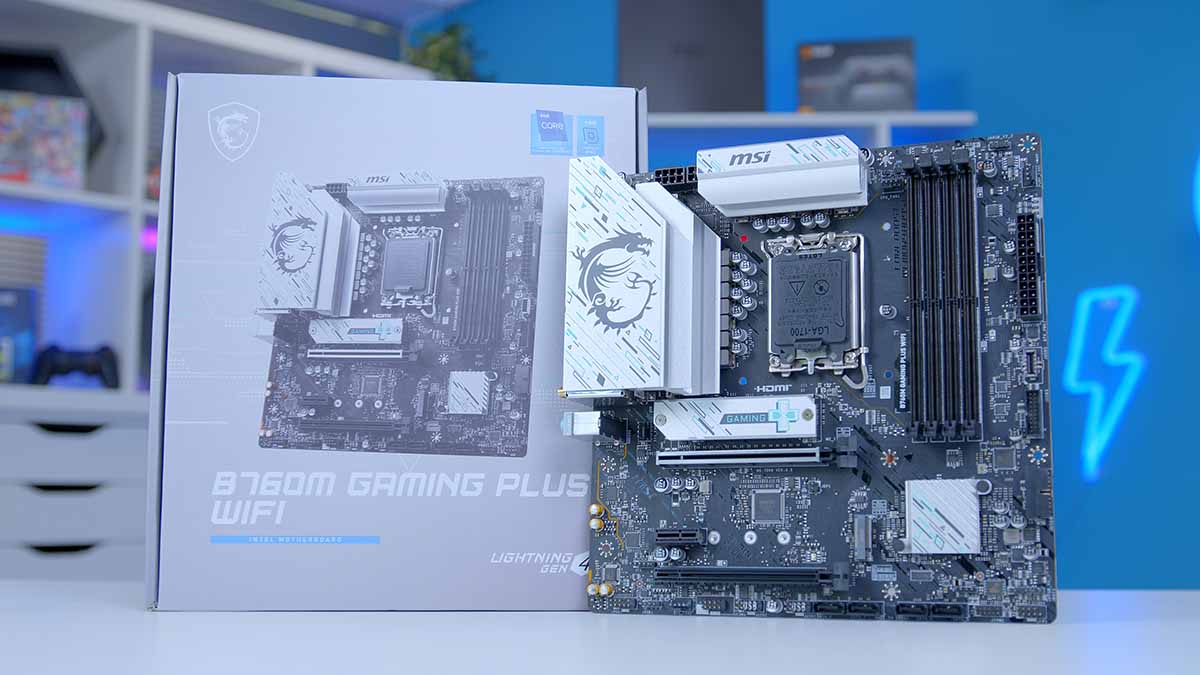
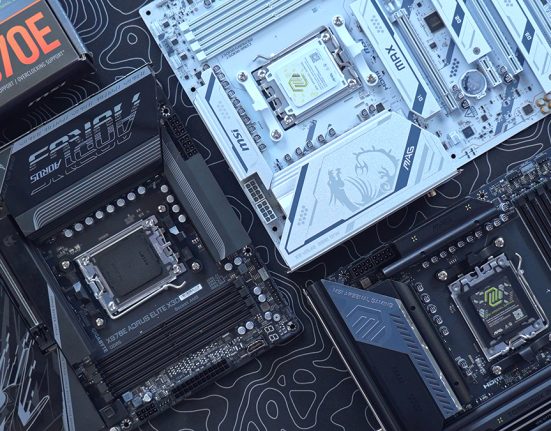

![FI_[DP056] Antec flux M + 9060XT](https://geekawhat.com/wp-content/uploads/2025/12/FI_DP056-Antec-flux-M-9060XT-551x431.jpg)
